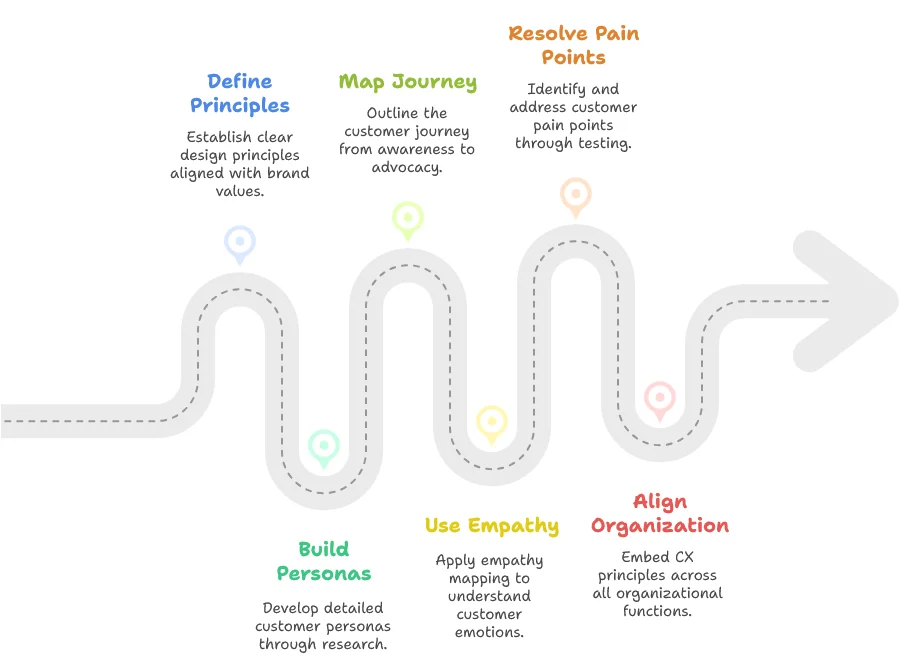Customer Experience (CX) Design: Importance, Strategy & Implementation

In the modern digital economy, Customer Experience (CX) Design is no longer a buzzword it’s a business imperative. Brands are no longer judged only by what they sell, but by how they make their customers feel across every interaction.
So how do you create a compelling customer experience design strategy that not only meets expectations but continually evolves with customer needs?
This guide dives deep into what CX design means, how it differs from UX, how to implement it effectively, and how to measure its impact.
What Is Customer Experience Design?
Customer Experience Design is the structured process of crafting and optimising the entire customer journey from the moment of first discovery to post-purchase support. Unlike UX (User Experience), which focuses on product usability, CX design spans the entire lifecycle of interactions including advertising, service delivery, customer support, loyalty programs, and everything in between.
According to a report by McKinsey, companies that lead in customer experience outperform laggards by nearly 80% in terms of profitability source.
CX vs. UX: What’s the Difference?
While UX Design ensures digital experiences are smooth and intuitive, CX Design looks at the broader emotional and perceptual experience a customer has with a brand across all channels.
| Factor | User Experience (UX) | Customer Experience (CX) |
|---|---|---|
| Focus | Interaction with digital products | Entire customer-brand relationship |
| Scope | Task-level (e.g. form submission) | Journey-level (e.g. brand discovery to loyalty) |
| Goal | Usability, accessibility, satisfaction | Emotional connection, trust, retention |
| Tools | Wireframes, usability testing, UI design | Journey maps, customer personas, empathy maps |
UX is a subset of the CX ecosystem. A product may be usable (UX) but still lead to dissatisfaction if, say, after-sales support is poor (CX).
Why Is Customer Experience Design Important?
1. Increases Loyalty and Spend
Customers who rate a brand 5 out of 5 on experience are more than twice as likely to repurchase, and 80% are willing to spend more for a better experience source.
2. Reduces Churn and Negative Feedback
Thoughtfully designed interactions reduce friction and disappointment. Anticipating customer needs across channels lowers frustration and builds trust.
3. Builds a Competitive Moat
In commoditised markets, experience becomes the primary differentiator. Think of how Apple’s store experience adds as much value as its products.
Building a Customer Experience Design Strategy

Step 1: Define Clear Design Principles
Align your experience with the brand’s mission, tone, and value proposition. CX design principles may include:
-
Simplicity in navigation, even in complex journeys
-
Consistent performance metrics linked to customer goals
-
Empathy-driven interaction at every stage
-
Respect for customer agency and control
These principles should be referred to every time you create or revise an experience.
Step 2: Build or Update Customer Personas
Use qualitative (interviews, focus groups) and quantitative (CRM, surveys, analytics) research to create detailed, dynamic personas. Key attributes include:
-
Motivations and pain points
-
Device and channel preferences
-
Emotional states during key touchpoints
-
Update personas regularly based on market shifts, technology adoption, or internal feedback loops.
Step 3: Map the Full Customer Journey
A customer journey map outlines each step a user takes from awareness to advocacy. This allows you to:
-
Identify redundant steps or decision fatigue
-
Spot opportunities for new touchpoints
-
Uncover friction areas causing drop-offs
Tools like Miro, Smaply, or Lucidchart can help visualise this map.
Step 4: Use Empathy Mapping and Address Emotional Needs
Empathy Mapping, as described by the Nielsen Norman Group, helps teams visualise what customers say, do, think, and feel.
Pair this with real-time feedback tools (live chat, exit polls, email surveys) to gauge:
-
Emotional triggers behind churn
-
Satisfaction drivers during high-value journeys
-
Preferences around privacy, speed, tone, etc.
Step 5: Identify and Resolve Pain Points
Regularly conduct CX audits to identify:
-
Drop-off zones (e.g. checkout abandonment)
-
Confusion triggers (e.g. vague CTAs)
-
Service failure loops (e.g. long response times)
Once diagnosed, A/B test interventions copy tweaks, layout changes, automation vs. live chat to validate what actually works.
Step 6: Create Organisational Alignment
CX design cannot succeed in silos. Embed CX principles across:
-
Sales playbooks
-
Brand voice guides
-
Customer service training
Every department must reflect the same experience promise. Create a governance system (e.g. CX Council) to uphold experience standards across platforms and people.
Implementing & Measuring Impact
Launch Thoughtfully
Pilot experience changes with a small segment of users. Track real-time signals (click-through rates, NPS, response time) before scaling.
Define Key Metrics
Examples of CX metrics:
-
CSAT (Customer Satisfaction Score)
-
CES (Customer Effort Score)
-
NPS (Net Promoter Score)
-
Repeat purchase rate
-
Average resolution time
Tie each metric to a moment on the journey. For example, CES after checkout or CSAT after live chat.
Iterate, Test, Improve
CX design is never done. Use methods like:
-
Heatmaps for website friction
-
Mystery shopping for offline flows
-
Text analysis on support tickets
Collect feedback. Refine hypotheses. Test again. Keep evolving.








